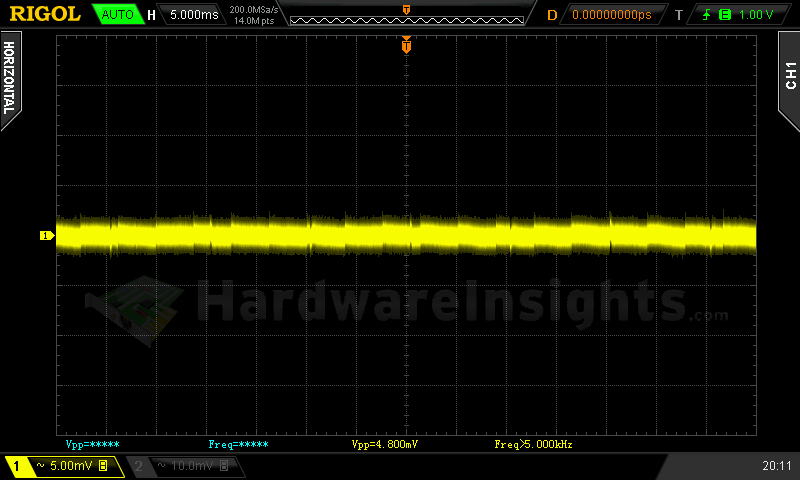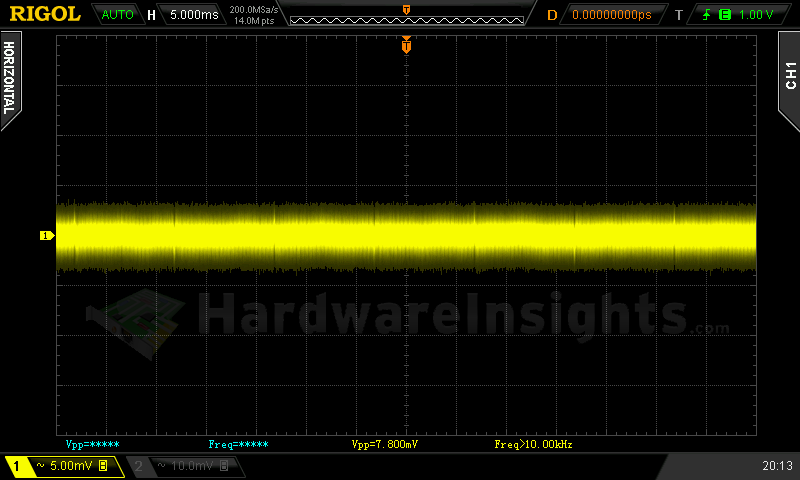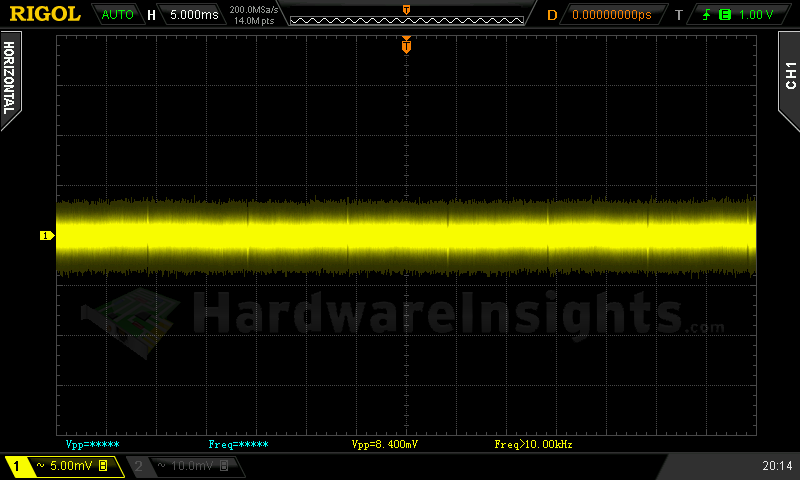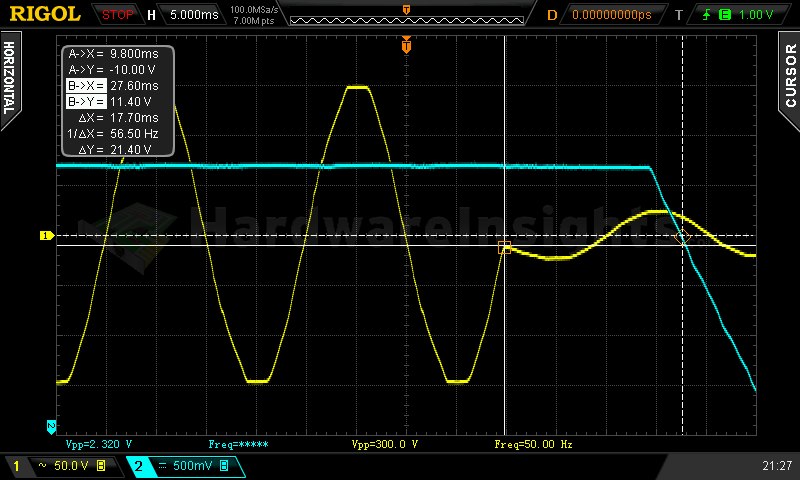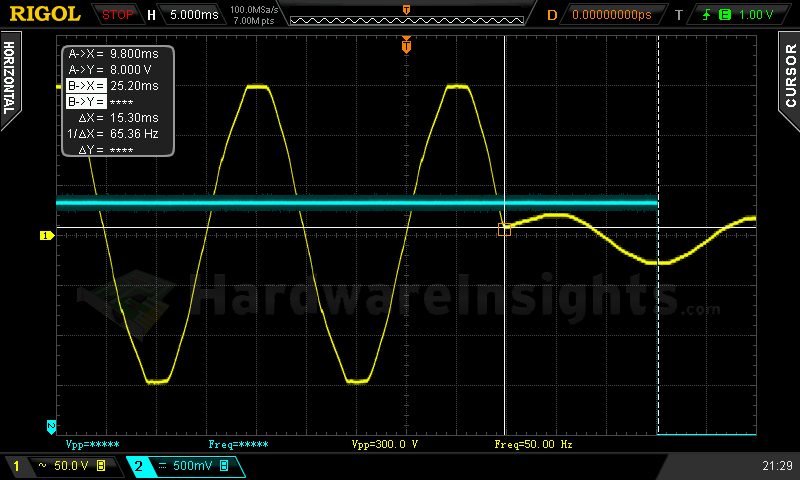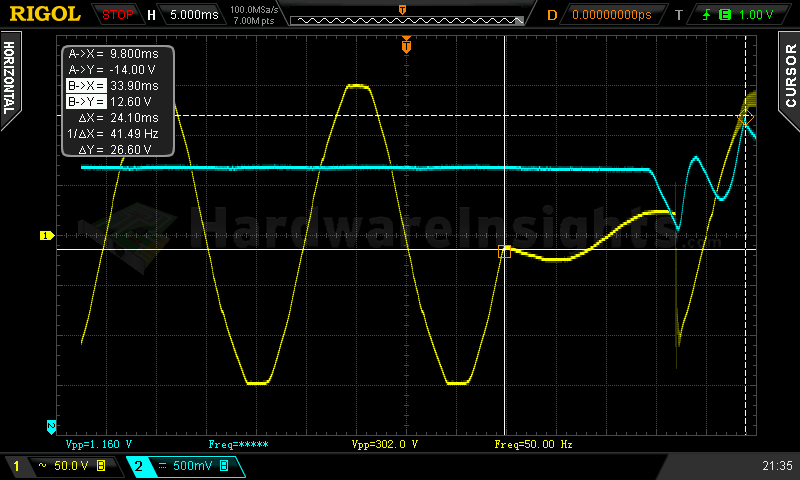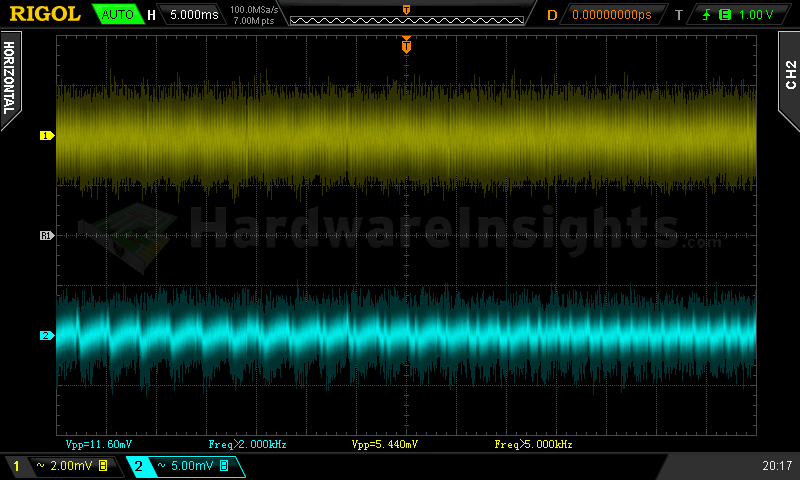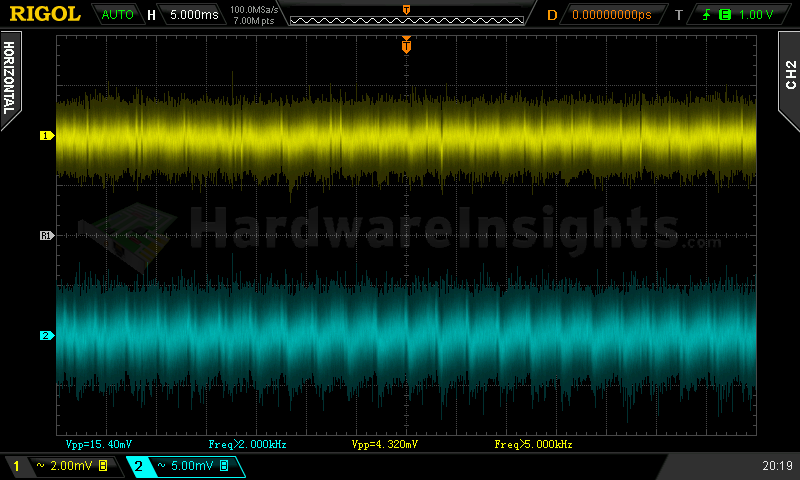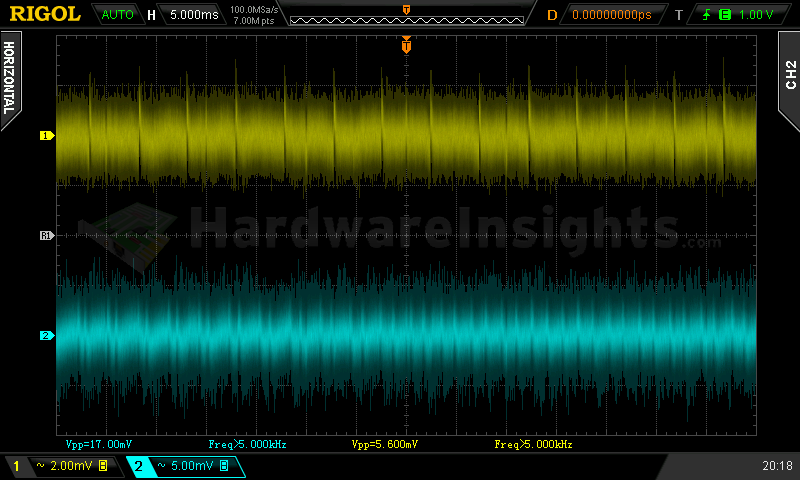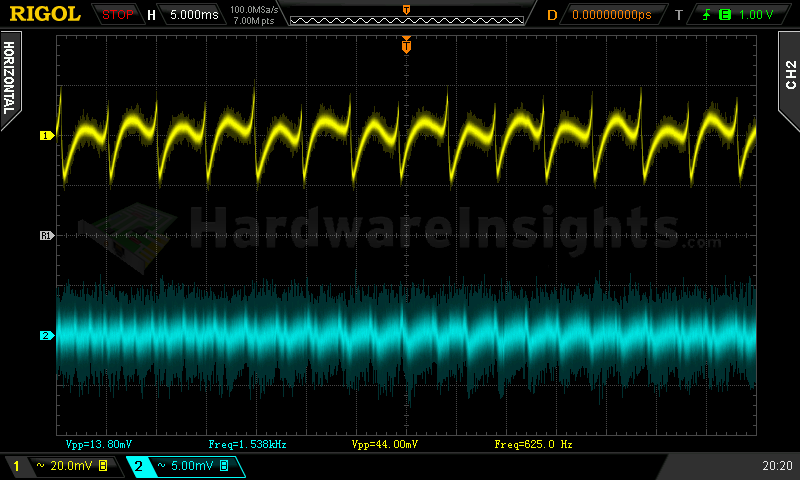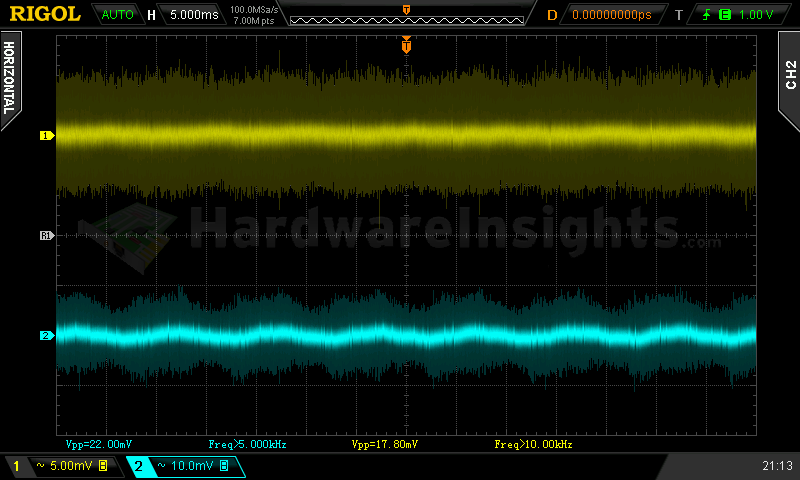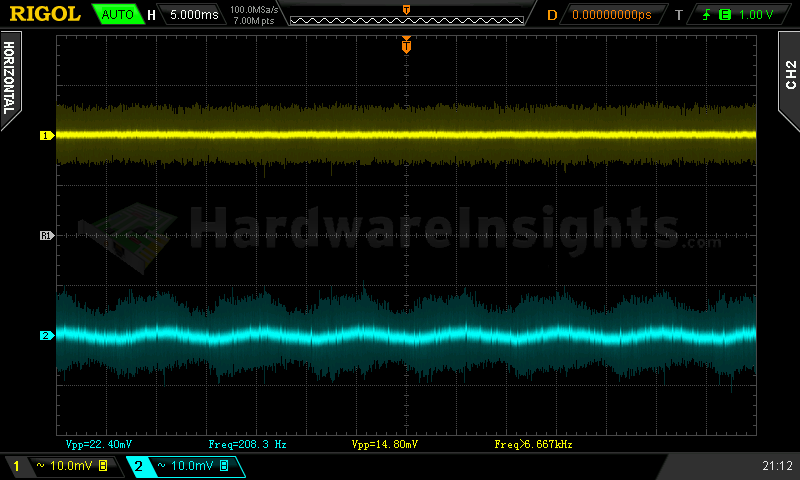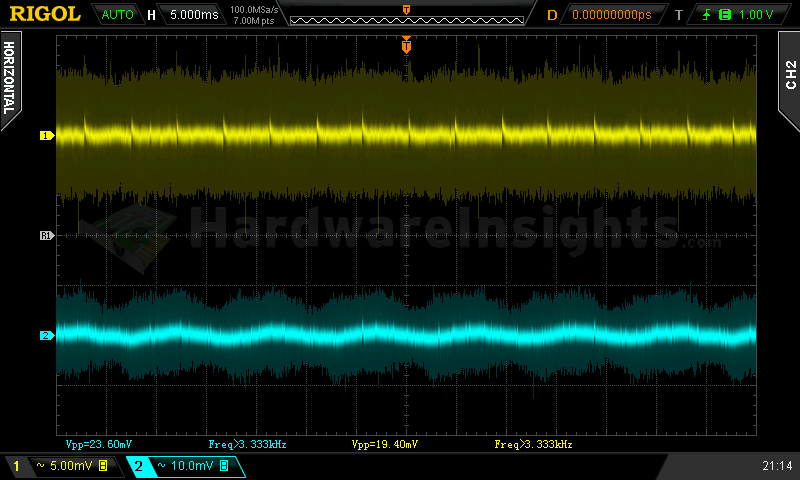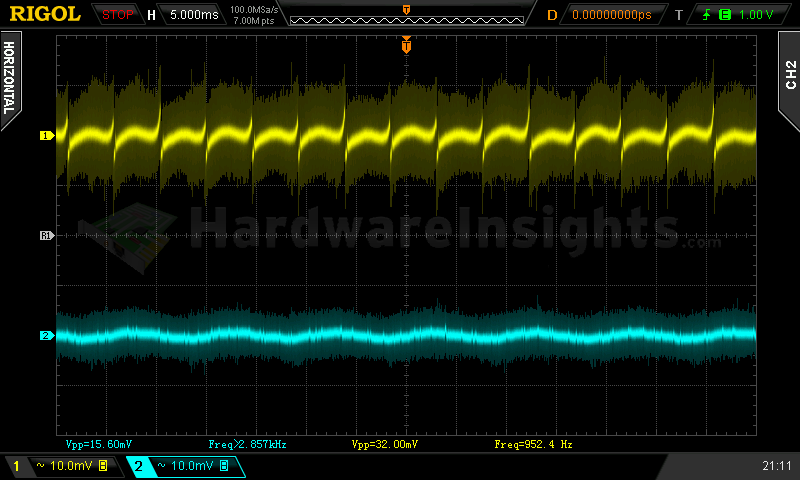Contents
- 1Introducing the Antec High Current Gamer M 750 W (HCG-750M)
- 1.1Packaging and accessories
- 2Connectors & cabling
- 2.1Casing & cooling
- 3Input filtering
- 4Primary side
- 4.1+5 V stand-by rail
- 5Secondary side
- 5.1Build quality
- 6Load testing
- 6.1Loading +5 V SB
- 6.2Hold-up time
- 6.3Combined loading
- 6.4Combined loading ripple
- 6.5Crossloading, overloading
- 6.6Crossloading, overloading ripple
- 6.7Fan speed, temperatures and noise
- 7Conclusion and evaluation
- 7.1Thanks
- 7.2Discussion
Load testing
Loading +5 V SB
As always, all load testing is done according to our testing methodology. The voltage regulation and ripple suppression is OK for mainstream. Efficiency is average, about 75 %.
| Output (W) | Load (A) | Voltage (V)/ ripple (mV) | Input (W) | Efficiency/power factor |
| 0 | 0 | 5.13/4.800 | 0 | —/0.010 |
| 19.36 | 2.91 | 5.06/7.800 | 19.63 | 75.0 %/0.531 |
| 23.26 | 3.46 | 5.06/8.400 | 23.26 | 75.2 %/0.553 |
+5 V SB ripple (left to right): 0 A; 2.91 A; 3.46 A
Hold-up time
As we can see on the oscilloscope screenshot, the hold-up time of the HCG-750M +12 V rail is good, 17.7 ms.
The hold-up time of the power good signal is slightly lower than ATX minimum (16 ms), 15.3 ms. Though it could be slightly better, it is still not that bad. At least the voltage hold-up time is longer than PG HUT, as it should be.
When interrupting for 17.7 ms, I saw some voltage spikes appear, which are over maximum allowed (12.6 V). At 15.3 ms it is well within the spec.
Combined loading
Combined loading was OK for the Antec HCG-750M. Firstly, let’s talk about the voltage regulation. As this is a single-rail topology with DC-DC converters (though not synchronously rectified), the results are still expected to be good. Indeed, all the positive rails stayed within 3 %, the worst case was with +5 V SB which at 5.12 V was 2.4 % from nominal. I think this result is comparable or maybe even better than for most of the G/S12G series models I have seen. For this price this is good.
| Output power | Load/ voltage +5 V SB | Load/ voltage +3.3 V | Load/ voltage +5 V | Load/ voltage +12 V | Load/ voltage −12 V | Input power | Efficiency/ power factor |
| 3.9 %/ 29.24 W | 0 A/ 5.12 V | 0 A/ 3.36 V | 0.402/ 5.09 V | 1.845 A/ 12.19 V | 0.396 A/ −11.88 V | 45.57 W | 64.2 %/ 0.828 |
| 20 %/ 159.65 W | 0.543 A/ 5.10 V | 3.04 A/ 3.35 V | 2.309 A/ 5.08 V | 10.70 A/ 12.16 V | 0.402 A/ −12.07 V | 190.8 W | 83.7 %/ 0.926 |
| 40 %/ 302.28 W | 1.55 A/ 5.06 V | 4.52 A/ 3.36 V | 4.96 A/ 5.07 V | 20.51 A/ 12.15 V | 0.405 A/ −12.17 V | 352.6 W | 85.7 %/ 0.949 |
| 60 %/ 454.78 W | 1.90 A/ 5.06 V | 6.84 A/ 3.36 V | 6.10 A/ 5.07 V | 31.8 A/ 12.15 V | 0.404/ −12.17 V | 529.3 W | 85.9 %/ 0.965 |
|
80 %/ 596.94 |
2.38 A/ 5.01 V | 11.20 A/ 3.32 V | 10.39 A/ 5.04 V | 40.5 A/ 12.11 V | 0.407 A/ −12.30 V | 708.1 W | 84.3 %/ 0.972 |
| 100 %/ 750.82 W | 2.86 A/ 5.00 V | 12.57 A/ 3.33 V | 12.25 A/ 5.04 V | 51.9 A/ 12.10 V | 0.401 A/ −12.31 V | 894.9 W | 83.9 %/ 0.977 |
We reached maximum efficiency of almost 86 %. The maximum Ecova measured was about one and half a percent higher (though at 50% load) so I think this is correct, within reasonable margin of error. If the maximum is not 88 % as Antec says, then at least 87 % for sure. Though at very low loads the efficiency is pretty poor.
Combined loading ripple
The ripple values of the HCG-750M are very nice. The −12 V rail is somewhat worse, but otherwise really good results, much better than of S12G/G units I have seen so far.
| Output % | Ripple +5 V SB | Ripple +3.3 V | Ripple +5 V | Ripple +12 V | Ripple −12 V |
| 3.9 | 5.440 mV | 4.320 mV | 5.600 mV | 17.00 mV | 44.00 mV |
| 20 | 5.440 mV | 6.800 mV | 5.600 mV | 16.60 mV | 42.40 mV |
| 40 | 9.600 mV | 8.000 mV | 9.400 mV | 20.00 mV | 39.20 mV |
| 60 | 14.00 mV | 5.040 mV | 12.60 mV | 22.80 mV | 33.60 mV |
| 80 | 14.40 mV | 6.40 mV | 14.40 mV | 25.20 mV | 37.20 mV |
| 100 | 17.80 mV | 14.80 mV | 19.40 mV | 23.60 mV | 32.00 mV |
Ripple 3.9% load (left to right): +5 V SB; +3.3 V; +5 V; −12 V. The second channel is connected to +12 V.
Ripple 100% load (left to right): +5 V SB; +3.3 V; +5 V; −12 V. The second channel is connected to +12 V.
Crossloading, overloading
Crossloading tests went fine, as is expected from a platform utilizing DC-DC converters. The voltage regulation was mostly the same. Efficiency dropped further, even under 80 % with a crossload of the minor rails. I tried overloading the V1 +12V rail and the unit mostly turned off approx. at 53.5 A. The +5 V rail OCP is set to about 29.5 A. It was futile to even try the sweater on, but the overtemperature protection is working as it kicked in after 3:21 at full load with stuck fan. This is nice for mainstream unit.
| Output power | Load/ voltage +5 V SB | Load/ voltage +3.3 V | Load/ voltage +5 V | Load/ voltage +12 V | Load/ voltage −12 V | Input power | Efficiency/ power factor |
| 15 %/ 111.75 W | 0.539 A/ 5.09 V | 23.8 A/ 3.34 V | 0.340 A/ 5.08 V | 1.894 A/ 12.15 V | 0.393 A/ −12.30 V | 148.4 W | 75.3 %/ 0.917 |
| 21 %/ 157.22 W | 0.539 A/ 5.09 V | 0 A/ 3.34 | 25.1 A/ 5.06 V | 1.870 A/ 12.14 V | 0.390 A/ −12.28 V | 197.4 W | 79.7 %/ 0.926 |
| 100 %/ 750.82 W | 0.535 A/ 5.07 V | 0 A/ 3.31 V | 0.417 A/ 5.05 V | 61.1 A/ 12.04 V | 0.406 A/ −12.30 V | 885.7 W | 84.7 %/ 0.977 |
| 87 %/ 654.57 W | 3.29 A/ 4.98 V | 18.89 A/ 3.29 V | 13.14 A/ 5.00 V | 56.6 A/ 8.95 V | 0.311 A/ −9.08 V | 807.0 W | 81.1 %/ 0.976 |
However, as many times before even with Seasonic units, the OPP does not work properly. The maximum power I got from this unit was about 850 W. Then with increased load the +12 V (and also −12 V) was dropping heavily which included in lower power draw as well. Though lately the unit managed to always slightly increase the output voltage, this continued all the way under 9 V. I think we have a new record of how low some PSU output voltage can fall without the unit vouchsafing to do anything about that. That resulted in only 650 W of output power. Though I think hardly any modern computer I know will still be working with this (old +5 V heavy systems actually may as the minor rails provided stable output). I even tried applying the load very quickly with my latest expansion module, and it made almost no difference. So it is nice the unit has working OCP, but my requirement for mainstream is OPP, and here the unit will lose points as it clearly does NOT work.
Crossloading, overloading ripple
Here the ripple was similar to that of combined loading set of tests. The −12V rail was able to stay within 30 mV this time.
| Output % | Ripple +5 V SB | Ripple +3.3 V | Ripple +5 V | Ripple +12 V | Ripple −12 V |
| 15 | 7.600 mV | 6.400 mV | 10.00 mV | 8.800 mV | 34.40 mV |
| 21 | 4.640 mV | 5.600 mV | 5.360 mV | 8.000 mV | 38.00 mV |
| 100 | 15.00 mV | 14.80 mV | 13.60 mV | 12.00 mV | 29.6 mV |
| 87 | — | — | 18.80 mV | 25.20 mV | — |
Fan speed, temperatures and noise
The fan inside the Antec HCG-750M started spinning right away. In first three tests, it was only running under 700 RPM, then the speed increases quite rapidly with each subsequent test. At minimum speed it was pretty quiet though still noticeable, especially thanks to some kind of bearing noises. (Like the bearing was jumping between positions, pretty much like ball bearing fan do.) So this unit is definitely not good for ultra-silent configurations, but I guess nobody expects it for this price. At higher speed it was getting louder and especially over 1600 RPM the fan is really loud. I guess this is just another loud Seasonic unit after all.
| Output % | Fan speed (RPM) | Temperature intake/ outtake | Noise (dBA) |
| 3.9 | 662 | 20 °C/ 26 °C | 38.8 |
| 20 | 669 | 21 °C/ 29 °C | 38.8 |
| 40 | 680 | 22 °C/ 32 °C | 38.8 |
| 60 | 1024 | 22 °C/ 36 °C | 39.4 |
| 80 | 1602 | 22 °C/ 38 °C | 46.5 |
| 100 | 1933 | 23 °C/ 40 °C | 51.0 |
| CL 15 | 683 | 21 °C/ 31 °C | 38.8 |
| CL 21 | 680 | 21 °C/ 32 °C | 38.8 |
| CL 100 | 1735 | 22 °C/ 39 °C | 48.3 |
| OL 87 | 1923 | 21 °C/ 40 °C | 51.5 |
But it makes sense as with only 80 PLUS Bronze efficiency, the unit has to dispose of almost 150 W of waste heat. That is very much heat. So even with 135mm fan it needs to move some amount of air, which results in high speed and high noise. And even then the unit was getting to 40 °C on the outtake. After overheating tests the fan was spinning on full speed (1950 RPM) with outtake temperature reaching 46 °C. At least that it has quality capacitors which can handle that. But still, as always, I recommend good cooling, preferably at bottom-mounted position, and to keep the unit under 70% load. Over such load it will really become loud.
